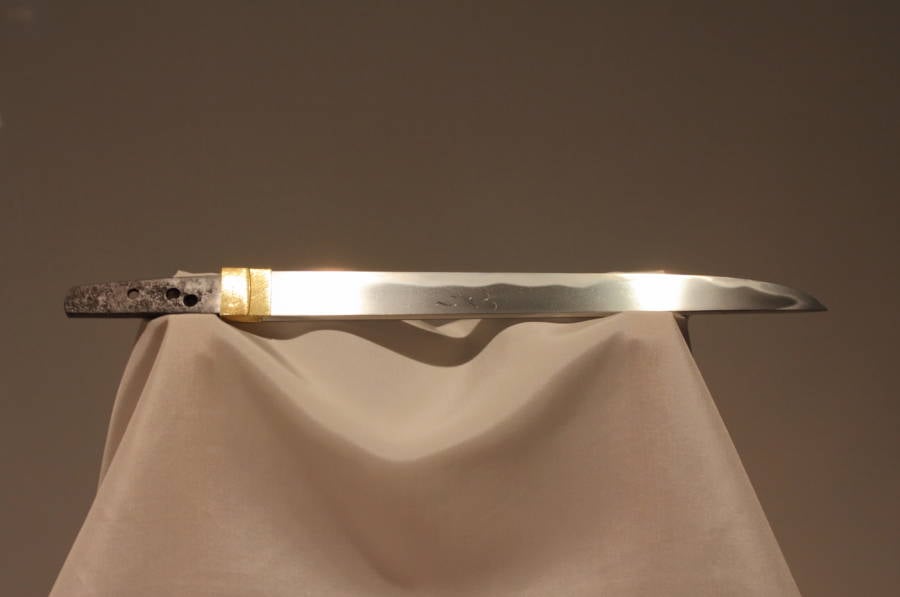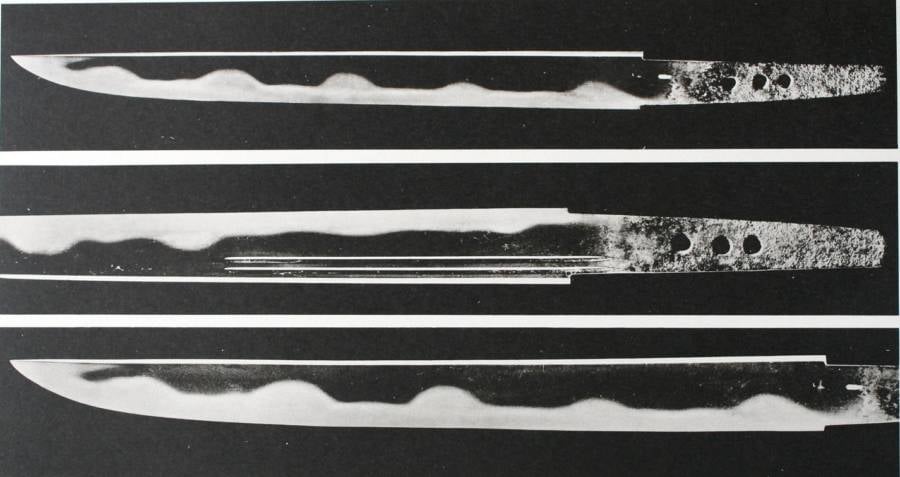Legend says that his swords were so well-made, their layers went to a point that was but one atom thick.
Masamune, formally known as Goro Nyudo Masamune, lived during a time when samurai rode into battle and died honorable deaths. His legendary rivalry with master Muramasa and the tragic loss of his work over time have made Masamune into a sort of myth.
Beside every samurai was a sword. But only the best samurai carried a Masamune sword into battle.
His Early Career

Wikimedia CommonsAn exquisite example of a Masamune sword. Note the wavy line along the side of the blade, a hallmark of the swordsmith’s technique.
Masamune was born around 1264 in Kanagawa Prefecture, Japan, a coastal territory just south of Tokyo. Masamune’s exact date of birth and death are unknown.
As a young man, he studied under swordsmith Shintogo Kunimitsu where he perfected the art form of the Soshu swordmaking technique, one of five classes of Japanese swords to come out of the old period of swordsmithing in the late 1200s and early 1300s.
Sword experts identified five different sword types based on the region where they were produced. For example, a sword from Kyoto was fashioned differently from one in Nara, Kanagawa or Okayama.
Masamune learned the art of swordsmithing in Kanagawa, which was the seat of the feudal government in the Kamakura Period of Japanese history. It was a time characterized by fantastic Japanese art, and the Kamakura Shogunate, or feudal military government in charge.
As Masamune rose to prominence in his masterful swordmaking, so too did the Samurai warriors. This was no coincidence, this was thanks in part to Masamune’s technique.
Masamune The Master
The legendary swordsmith discovered that he could create weapons made entirely of steel and this would improve their strength and flexibility.
He brought the metal to high temperatures to get rid of impurities. However, high temperatures tended to make the swords brittle. To solve that problem, Masamune blended soft and hard steels together in layers to keep the swords from breaking.
The process created a unique wavy pattern along the Hamon, or blade, of a katana — or sword.

Wikimedia CommonsAnother Masamune masterpiece with the curvy wave pattern.
Further, the harder steel could penetrate the armor of enemies more readily. Plus, the design was lightweight enough for warriors to wield them on horseback. Thus, the Masamune sword was perfected.
Masamune’s technique was ahead of its time throughout the world, even in Europe and other parts of Asia where swordsmithing was a well-defined art.
Samurai of Kanagawa liked the design so much that they wanted more of the master’s work. By 1287, at the age of 23, Emperor Fushimi proclaimed Masamune his chief swordsmith.
Masamune made more than just swords. He fashioned knives and daggers that withstood the tests of battle as well. His impenetrable weaponry manifested for the Japanese an impenetrable military, and country.
Masamune And Muramasa, The Legend
It didn’t take long for Masamune to develop a swordsmithing rival.
Japanese legend says that a one Muramasa, an ill-tempered swordsmith who forged swords with the sole purpose of bloodlust in mind, challenged Masamune’s swords to a duel. This wasn’t a traditional sword fight. Instead of the masters dueling for life or death, the swordsmith’s put their blades, points down, into a river.
Muramasa claimed victory because he noticed that his sword sliced everything that it touched.
A monk passing by the spot of the duel disagreed with Muramasa. He said that the Masamune sword only sliced through leaves and sticks while sparing the fish. It was this subtlety that elevated Japan’s greatest swordsmith to the status of legend.
The epitome of Masamune’s work, which best showcases its durability, is the Honjo sword. Legend says that Masamune made the sword so well, its layers went to a point that was just one atom thick. It survived until World War II.
A Legendary Masamune Sword
The Honjo Masamune sword received its name from the first prominent general who owned it. Honjo Shigenaga led his troops into battle at Kawanakajima in 1561. The general fought another man of similar rank, whose sword cleaved Shigenaga’s helmet in half.

Wikimedia Commons A depiction of the Battle of Kawanakajima. Samurai swordsmen fought on horseback.
However, the sword didn’t kill the general. Shigenaga fought back instantly and killed his counterpart.
Per Japanese tradition, Shigenaga took the sword of his fallen enemy.
By 1939, the Honjo Masamune was in the possession of Japan’s famous Tokugawa family which ruled Japan for 250 years. The sword was a symbol of the Tokugawa Shogunate. The Japanese government declared Honjo Masamune an official Japanese treasure.
But World War II would change this. At the end of the war, the U.S. Army demanded that all Japanese citizens turn over their weapons, including their swords. Nobles were furious.
To set an example, Tokugawa Iemasa, of Japan’s ruling family, turned over his clan’s prized swords in December of 1945. The Honjo Masamune consequently made the journey across the Pacific in a ship. From there, it was lost to oblivion.
No one knows if someone melted the sword for scrap or if it miraculously survived. If the Honjo Masamune was indeed that legendary, it might still be around today. One can hope.
Masamune’s Legacy
There are some Masamune relics still in existence. Japanese museums, particularly the Kyoto National Museum, own some pieces. Private citizens in Japan own others. There is one sword in the Museum der Stadt Steyr in Austria.

Wikimedia Commons A Masamune sword on display in Austria.
In America, at least one Masamune sword exists in Missouri. Tucked away in the Truman Library is a gleaming artifact that is more than 700 years old. The katana, which is in nearly perfect condition, was a gift presented to President Harry S. Truman from U.S. Army Gen. Walter Krueger, one of the commanders of U.S. forces occupying post-war Japan. Krueger received the sword from a Japanese family as part of the conditions of surrender.
No one should expect to see this rare sword on display any time soon. Thieves broke into the Truman Library in 1978 and stole more than $1 million worth of historic swords. To this day, no one knows where the swords ended up.
Even though Masamune has been dead for nearly 700 years, his legacy continues to surprise historians.
In 2014, scholars confirmed the existence of a Masamune original, a sword that was missing for 150 years.
Called Shimazu Masamune, the sword was a gift to the emperor’s family in 1862 for a wedding. Eventually, the sword found its way to the Kenoe family, an aristocratic family who had close ties to the imperial family going back several generations. After a donor obtained the sword, he gave the national treasure to the Kyoto National Museum where it belongs.
Much like the Shimazu sword, the Honjo Masamune may reappear sometime in the future. Someone in America may unknowingly own the most epic of legendary swords in Japanese history.
For another look at Japanese swords, check out this rare find that someone discovered in an attic. Or, find out more about how the Japanese keep their ancient sword fighting traditions alive in the 21st century.





